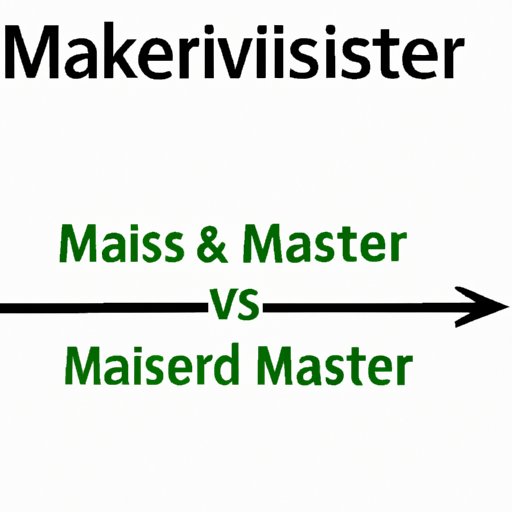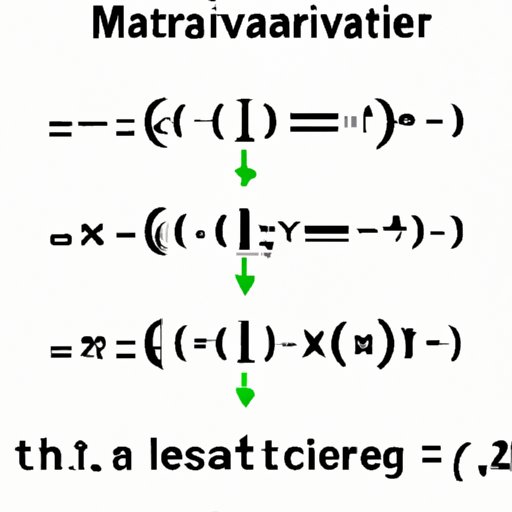How to Find the Inverse of a Matrix
Matrices are used extensively in a wide range of mathematical fields and applications. They can be used to solve systems of linear equations, model physical systems, and transform data. One of the most important operations that can be performed on a matrix is matrix inversion. In this article, we will explore how to find the inverse of a matrix step-by-step.
The Step-By-Step Guide to Finding the Inverse of a Matrix
Before we begin, it’s important to note that not all matrices can be inverted. A matrix must be square (i.e., have the same number of rows as columns) and have a non-zero determinant in order to be invertible.
Step 1: Write the matrix
Start by writing the matrix that you want to invert.
For example, let’s consider the following 2×2 matrix:
$$ \begin{bmatrix} 1 & 2 \\ 3 & 4 \end{bmatrix} $$
Step 2: Find the determinant
The determinant of a matrix is a scalar value that can be used to determine if the matrix is invertible. To find the determinant, we use the following formula for a 2×2 matrix:
$$ det(A) = ad – bc $$
Where A is the matrix:
$$ \begin{bmatrix} a & b \\ c & d \end{bmatrix} $$
Applying this formula to our example matrix, we get:
$$ det\begin{pmatrix} 1 & 2 \\ 3 & 4 \end{pmatrix} = (1 \times 4) – (2 \times 3) = -2 $$
Since the determinant is non-zero, we know that this matrix is invertible.
Step 3: Find the matrix of minors
To find the matrix of minors, we take the determinant of each submatrix obtained by removing one row and one column from the matrix. For example, the submatrix obtained by removing the first row and first column of our example matrix is:
$$ \begin{bmatrix} 4 \end{bmatrix} $$
So the matrix of minors for our example matrix is:
$$ \begin{pmatrix} 4 & -3 \\ -2 & 1 \end{pmatrix} $$
Step 4: Find the matrix of cofactors
The matrix of cofactors is obtained by multiplying each element of the matrix of minors by -1 raised to the power of the sum of its row and column numbers. For example, the element in the first row and second column of the matrix of minors is -3. Since the sum of its row and column numbers is even (1+2=3), the corresponding element in the matrix of cofactors is simply -3. The matrix of cofactors for our example matrix is:
$$ \begin{pmatrix} 4 & -3 \\ 2 & -1 \end{pmatrix} $$
Step 5: Transpose the matrix of cofactors
The transpose of a matrix is obtained by flipping its rows and columns. For our example matrix, the transpose of the matrix of cofactors is:
$$ \begin{pmatrix} 4 & 2 \\ -3 & -1 \end{pmatrix} $$
Step 6: Multiply by the reciprocal of the determinant
The inverse of a matrix is obtained by multiplying its transpose by the reciprocal of its determinant. For our example matrix, the determinant is -2, so the reciprocal is -1/2. Multiplying the transpose of the matrix of cofactors by -1/2, we get the inverse of the original matrix:
$$ \begin{pmatrix} -2 & 1 \\ 3/2 & -1/2 \end{pmatrix} $$
Matrix Inverse Tutorial: How to Find the Inverse of Any Matrix
Now that we’ve gone through the process of finding the inverse of a matrix step-by-step, let’s take a closer look at some of the key principles behind matrix inversion. One of the most important of these principles is the role of determinants.
Determinants are used to determine the invertibility of a matrix, as we saw in our earlier example. The determinant of a matrix can also be used to calculate the elements of the matrix inverse. We can write the inverse of a matrix A as:
$$ A^{-1} = \frac{1}{det(A)} adj(A) $$
Where adj(A) is the adjugate of A, which is obtained by transposing the matrix of cofactors of A.
With this formula, we can see that the elements of the inverse of A are directly related to its determinant and its matrix of cofactors.
To find the inverse of a matrix using this formula, we follow the same steps that we outlined earlier: find the determinant, find the matrix of cofactors, transpose it to get the adjugate, and multiply by the reciprocal of the determinant.
Solving for the Inverse of a Matrix: Tips and Tricks
While matrix inversion can be a straightforward process for small matrices, it can quickly become cumbersome for larger matrices. Here are some tips and tricks to make the process simpler and quicker:
- Use a calculator or computer program to find the determinant and/or inverse of larger matrices
- Use row operations to simplify the matrix before finding the determinant and/or inverse
- Use special properties of certain types of matrices (e.g., symmetric matrices) to simplify the process
Additionally, there are some common mistakes to avoid when finding matrix inverses:
- Forgetting to check if the determinant is non-zero before attempting to find the inverse
- Making errors in the process of finding the matrix of cofactors
- Forgetting to transpose the matrix of cofactors before finding the inverse
Matrix Inversion Made Easy: A Beginner’s Guide
If you’re new to linear algebra, matrix inversion can seem like a daunting task. Here’s a beginner-friendly explanation of how to find the inverse of a matrix:
Step 1: Write the matrix
Write down the matrix that you want to invert.
Step 2: Find the determinant
Use the formula for the determinant of a 2×2 matrix to find the determinant of your matrix. If the determinant is non-zero, continue to step 3.
Step 3: Swap the elements
Swap the elements in the main diagonal (i.e., the top left to bottom right diagonal) of the matrix. Then, change the sign of the other two elements. This gives you the matrix of cofactors.
Step 4: Transpose the matrix
Flip the matrix of cofactors along its main diagonal to get the adjugate.
Step 5: Multiply by the reciprocal of the determinant
Multiply the adjugate by the reciprocal of the determinant to get the inverse of the original matrix.

Mastering Matrix Inverses: Techniques and Strategies
If you’re working with very large matrices or need to find inverses quickly and efficiently, there are a number of advanced techniques and strategies that can help you. Here are a few:
- Use LU factorization to reduce the amount of computation required
- Use iterative methods such as the Jacobi method or Gauss-Seidel method to find approximate inverses
- Use software packages such as MATLAB or Mathematica to find inverses automatically
However, it’s important to note that these techniques can be complex and require a deeper understanding of linear algebra.
The Ultimate Guide to Matrix Inversion: Everything You Need to Know
Matrix inversion is a fundamental concept in linear algebra that has applications in a wide range of fields including physics, economics, and computer science. In this article, we’ve explored the basics of how to find the inverse of a matrix, including the importance of determinants, the use of the matrix of cofactors, and the role of software and advanced techniques in simplifying the process. We hope that this article has given you everything you need to know about matrix inversion.
Cracking the Matrix Inversion Code: Simple Methods for Finding the Inverse of Any Matrix
To recap, here are the key principles that we’ve discussed for finding the inverse of a matrix:
- Check if the determinant is non-zero
- Find the matrix of cofactors
- Transpose the matrix of cofactors to get the adjugate
- Multiply the adjugate by the reciprocal of the determinant to get the inverse
By following these steps, you can easily find the inverse of any invertible matrix. However, if you’re working with larger matrices or need to find inverses more quickly, there are a number of advanced techniques and software packages that can help simplify the process. Regardless of your level of expertise or your needs, matrix inversion is an essential tool to have in your mathematical toolbox.
